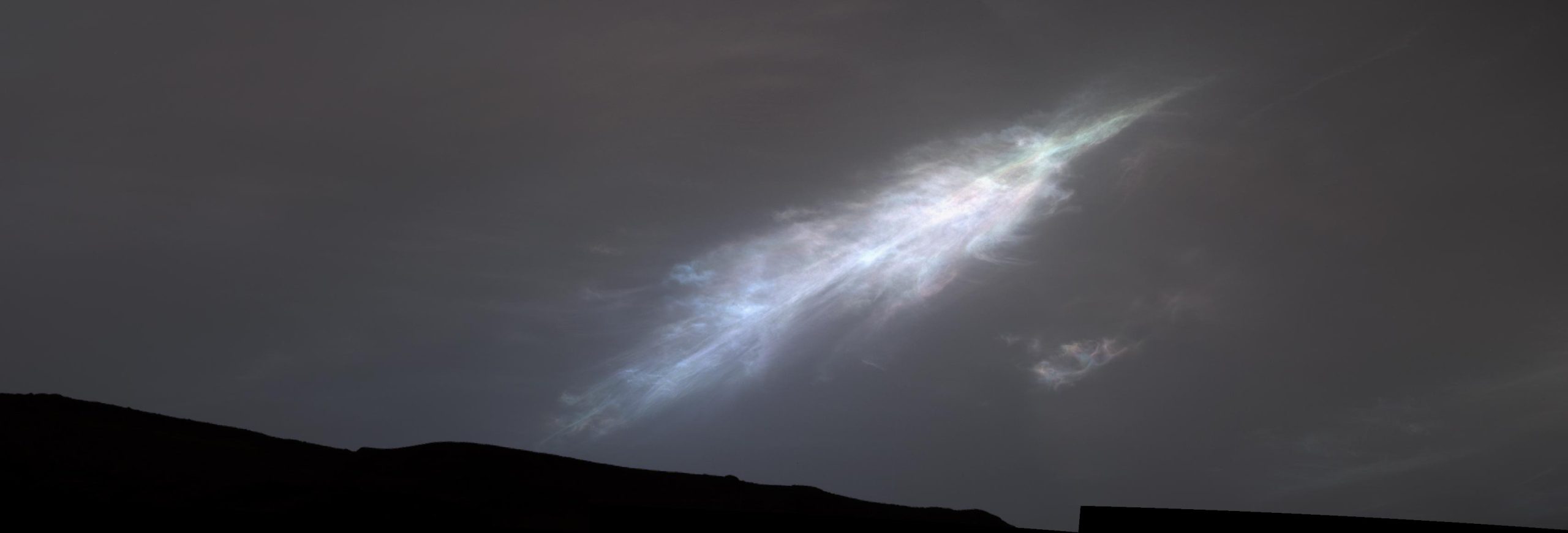

Roverul Curiosity Mars al NASA a captat această „lumină a soarelui” strălucind printre nori la apusul soarelui pe 2 februarie 2023, ziua Marte 3730 sau prima zi a misiunii. A fost prima dată când lumina soarelui, cunoscută și sub numele de raze aurorale, a fost văzută clar pe Marte. Credit: NASA/JPL-Caltech/MSSS
Un rover veteran pe Marte a surprins un apus de soare uimitor la începutul unei noi campanii de imagistică în nor.
Deși apusul marțian Unic capriciosȘi[{” attribute=””>NASA’s Curiosity rover captured one last month that really stands out. As the Sun descended over the horizon on February 2, rays of light illuminated a bank of clouds. These “sun rays,” also known as crepuscular rays, from the Latin word for “twilight,” are bright streaks that occur when incoming light is partially obstructed by a cloud or tall feature on the horizon. It was the first time sun rays have been so clearly viewed on Mars.
Curiosity captured the scene during the rover’s newest twilight cloud survey, which builds on its 2021 observations of noctilucent, or night-shining, clouds. While most Martian clouds hover no more than 37 miles (60 kilometers) above the ground and are composed of water ice, the clouds in the latest images appear to be at a higher altitude, where it’s especially cold. That suggests these clouds are made of carbon dioxide ice, or dry ice.
As on Earth, clouds provide scientists with complex but crucial information for understanding the weather. By looking at when and where clouds form, scientists can learn more about the Martian atmosphere’s composition and temperatures, and the winds within it.

This feather-shaped iridescent cloud was captured just after sunset on January 27, 2023, the 3,724th Martian day, or sol, of Curiosity’s mission. Studying the colors in iridescent clouds tells scientists something about particle size within the clouds and how they grow over time. Credit: NASA/JPL-Caltech/MSSS
The 2021 cloud survey included more imaging by Curiosity’s black-and-white navigation cameras, providing a detailed look at a cloud’s structure as it moves. But the recent survey, which began in January and will wrap up in mid-March, relies more often on the rover’s color Mast Camera, or Mastcam, which helps scientists see how cloud particles grow over time.
In addition to the image of sun rays, Curiosity captured a set of colorful clouds shaped like a feather on January 27. When illuminated by sunlight, certain types of clouds can create a rainbowlike display called iridescence.
“Where we see iridescence, it means a cloud’s particle sizes are identical to their neighbors in each part of the cloud,” said Mark Lemmon, an atmospheric scientist with the Space Science Institute in Boulder, Colorado. “By looking at color transitions, we’re seeing particle size changing across the cloud. That tells us about the way the cloud is evolving and how its particles are changing size over time.”
Curiosity captured both the sun rays and iridescent clouds as panoramas, each of which was stitched together from 28 images sent to Earth. The images have been processed to emphasize the highlights.
More About the Mission
Curiosity was built by NASA’s Jet Propulsion Laboratory, which is managed by the California Institute of Technology (Caltech) in Pasadena, California. JPL leads the mission on behalf of NASA’s Science Mission Directorate in Washington. Malin Space Science Systems in San Diego built and operates Mastcam. Curiosity’s Mastcam consists of two camera systems mounted on the rover’s mast, which allow for panoramic and stereoscopic imaging of the Martian surface. The Mastcam system was designed to support the mission’s scientific objectives, including the search for evidence of past or present habitable environments on Mars, and the study of Martian geology and climate. The Mastcam has been used to capture some of the most iconic and detailed images of Mars ever taken, including images of the planet’s diverse terrain, geologic features, and atmospheric phenomena.

„Mândru pasionat al rețelelor sociale. Savant web fără scuze. Guru al internetului. Pasionat de muzică de-o viață. Specialist în călătorii.”





More Stories
Simulările pe supercomputer dezvăluie natura turbulenței în discurile de acumulare a găurilor negre
Trăiește cu anxietate: sfaturi de specialitate despre cum să accepti o afecțiune de sănătate mintală
Noile cercetări asupra unei falii masive de tracțiune sugerează că următorul cutremur mare ar putea fi iminent